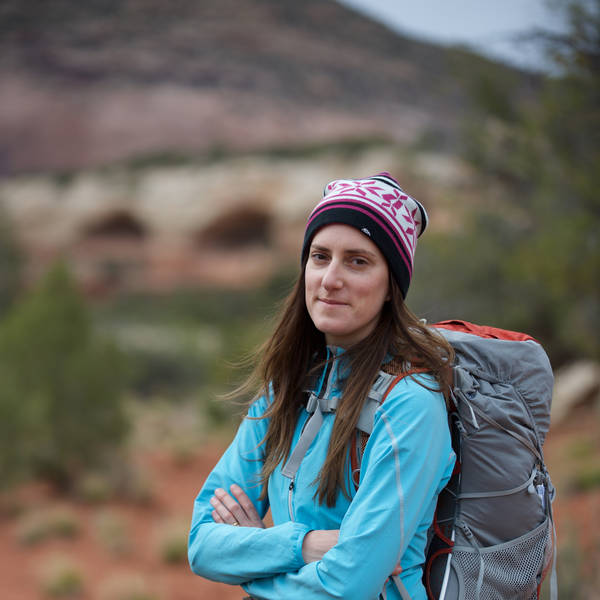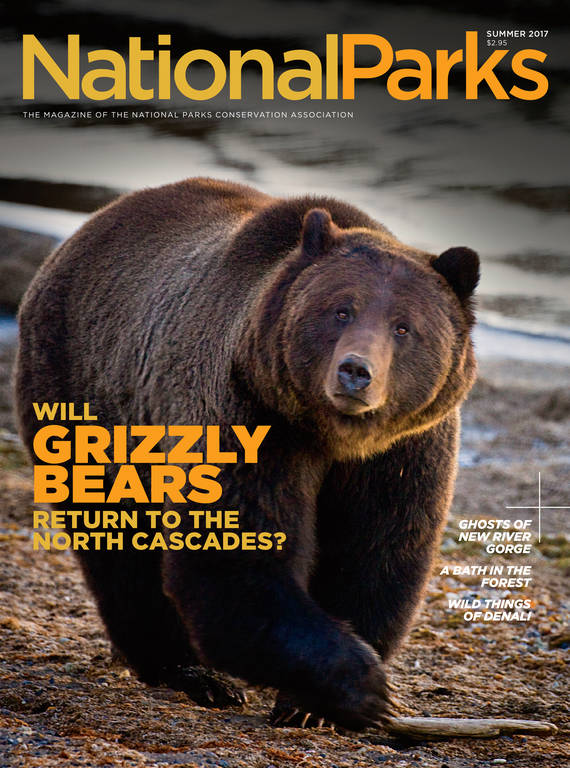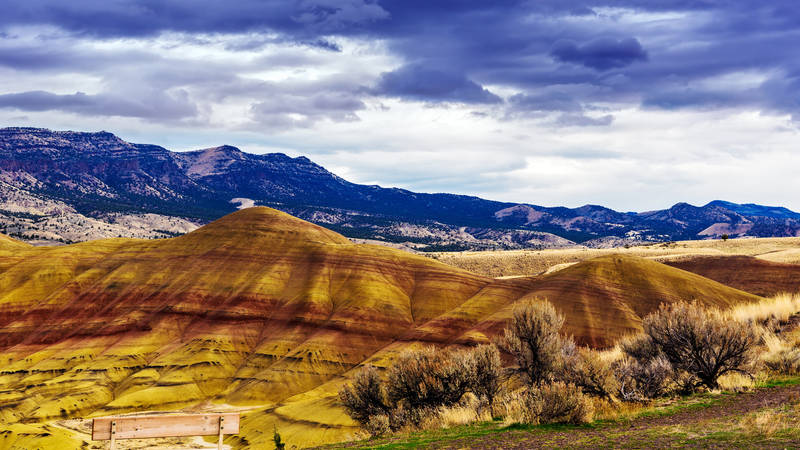Summer 2017
The Great Escape
Bill Sycalik walked away from an unfulfilling corporate job. Now he is on a quest to complete marathons in all 59 national parks.
Eight miles into a run through Theodore Roosevelt National Park, Bill Sycalik, a 45-year-old ex-management consultant, met his first bison herd. It was a soupy August day, and he had left the trailhead before 7 a.m. to outrun the heat. Keeping an eye on the galloping bison, he climbed up a ridge through knee-high grasses and scratchy sagebrush.
“Yeah, you see that little line there?” he asked with a whiff of exasperation in a selfie video, pointing toward a small valley dotted with bison. “That would be the trail.” That day in North Dakota, he also encountered a male buffalo crossing the path, a snake (nonrattling, thankfully) and resolve-straining 85-degree heat. Itchy ungulates had used trail markers as scratching posts, knocking them over so they were hard to spot. And game trails crisscrossed his route, causing him to wander off into the badlands more than a half dozen times. He also nearly ran out of water and traveled 4 more miles than he had planned — about 30 in all.
In Sycalik’s bid to run a marathon in every national park, it was the most challenging day yet. But he’d also reveled in long stretches of blissful solitude, sailing through spectacular multicolored buttes and hoodoos under a sprawling Western sky. These are the types of experiences he lives for, and the reason he’d set out on this unusual quest in the first place.
Running may not be a common activity in parks — it’s rarely, if ever, touted on websites or in brochures — but Sycalik is not the first to trot through these wild lands. Certain trails command a cult-like status among avid runners, such as the rim-to-rim route in the Grand Canyon in Arizona, a West-Rim-to-East-Rim route in Zion in Utah and the Wonderland Trail around Washington’s Mount Rainier. One other person has garnered media attention for a mission to run in every national park — Autumn Ray, an emergency room physician from Tucson, has vowed to run in all of them by the time she turns 40 in a few years — but Sycalik is likely the first person to attempt to run 26.2 miles in all 59 parks.
The idea for the marathon project sprouted when he was living in New York City, working long hours in business consulting. He felt disenchanted with his work and disconnected from nature; just reaching appropriate running trails could be complicated and expensive. He planned to quit his job and relocate to Denver after taking a couple months off. Then he read about the 2016 centennial of the National Park Service, and his thinking turned. What if he took the time to see every national park before landing in Colorado? Better yet, why not pursue his passion — trail running — in every park?
“Then I figured if I’m going to do it, I’m going to do it right,” Sycalik said. “I’m going to run a marathon in all 59 national parks. At the time, I didn’t even know if it was possible, but the idea energized me.” He meticulously researched an itinerary and decided he would pay for his travels with savings and the proceeds from a small crowdfunding campaign. Last June, he ran his first national park marathon in Acadia, jogging along historic carriage roads with views of Maine’s knuckly granite shores.
By early summer, Sycalik is expecting to complete marathons in all of the parks in the continental U.S. before turning to those in Hawaii and American Samoa. After that, he plans to settle down in Denver, work (hopefully at an outdoor gear company or nutrition business or as a motivational speaker) and replenish his savings before tackling the Alaskan parks next summer.
As he ticks off marathons, Sycalik has settled into a rhythm. Typically, he arrives in a park about three to five days before running and, while recovering from the previous marathon, he peruses exhibits and strolls trails. Come evening, if he’s not staying with friends or at a hostel, he camps in a rooftop tent on top of his Subaru. Dinner is often beans and rice and a few fresh veggies; Sycalik is vegan and swears the diet helps him recuperate faster. It’s also cheap, and he’s on a strict budget — $3,250 a month. But he still squeezes in some indulgences. After most marathons, he splurges on an order of French fries. His budget also has a line for entertainment, which he has used for extracurricular activities including a visit to Graceland and entry into an all-you-can-play pinball arcade in Asheville, North Carolina.
But the main attractions, of course, are the national parks. So far, Sycalik has tiptoed along windy ridges, leapt over streams and cruised through leafy forests at Shenandoah in Virginia. He has loped beneath towering red sandstone cliffs in Zion, strode through a green tunnel in a rainforest in Washington’s Olympic and climbed wildflower meadows in the jagged cirques of Glacier in Montana. Occasionally, local runners or rangers join him, but mostly he runs alone. Often, he sees only a handful of people on these backcountry routes. Sometimes he sees no one.
“When I do these 26-mile runs, they’re five to seven hours of just constant focus on beauty,” he said. “The running itself — and I say this and people think it’s kind of hokey or weird — but it makes you feel more animal-like, as if you’re part of the natural surroundings. You’re moving faster, and it makes you focus on nature and connect with it.”
Sycalik’s family and friends have been able to follow his progress on his blog, and they’ve generally supported the quest, though some have expressed concerns for his safety. “I worry about him in certain areas, especially in Alaska,” said Ryan McNaught, a friend and former colleague at Slalom Consulting. “What happens if you run across a polar bear, and he decides he wants to chase you?”
Sycalik hasn’t bumped into any polar bears, but he has dealt with other difficulties, such as the loneliness of traveling solo. He has also struggled with chronic plantar fasciitis and a pulled groin muscle from his run in Lassen Volcanic National Park in California. In Guadalupe Mountains National Park in Texas, some of the trails were so seldom frequented, they just petered out into the desert. At Voyageurs in Minnesota, he discovered that the trail he planned to run was mostly underwater thanks to some industrious beavers. And on Santa Cruz Island in California’s Channel Islands, he shooed away inquisitive island foxes nosing around his belongings. “They’re cute until they’re running away with your sandwich,” he said.
Although most people Sycalik meets are curious and supportive, some ask: Why speed through a park? Trail running, he says, allows him to cover more ground and see more. And running on a park road is a much more immersive, intimate experience than driving on one. “You might come across mule deer or Barbary sheep,” said Brian Whitehead, a ranger, who joined Sycalik on his marathon in Carlsbad Caverns National Park in New Mexico. “You might get to walk over and smell some of the flowers that are blooming instead of just driving by them.”
Sycalik hopes that his travels will inspire others to visit national parks — or maybe even to make big life changes. “You don’t have to take on some huge athletic endeavor,” he said. “I’m just trying to show people it’s possible to do something different. Take some time off, expose yourself to something new, see the world. If the rat race doesn’t have a finish line, you can’t ever win it, so why be in that kind of race in the first place?”
About the author
-
 Kate Siber
Kate SiberKate Siber, a freelance writer and correspondent for Outside magazine, is based in Durango, Colorado. Her writing has appeared in National Geographic Traveler and The New York Times. She is also the author of “National Parks of the U.S.A.,” a best-selling children’s book.



